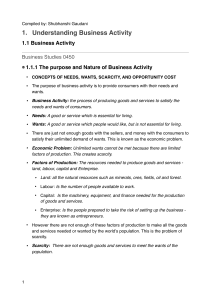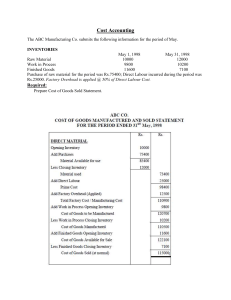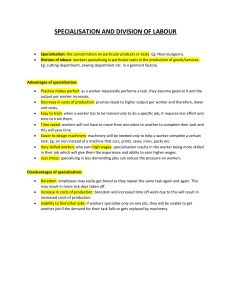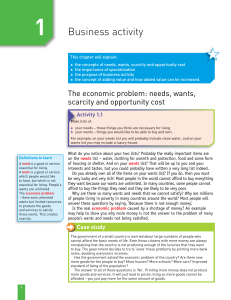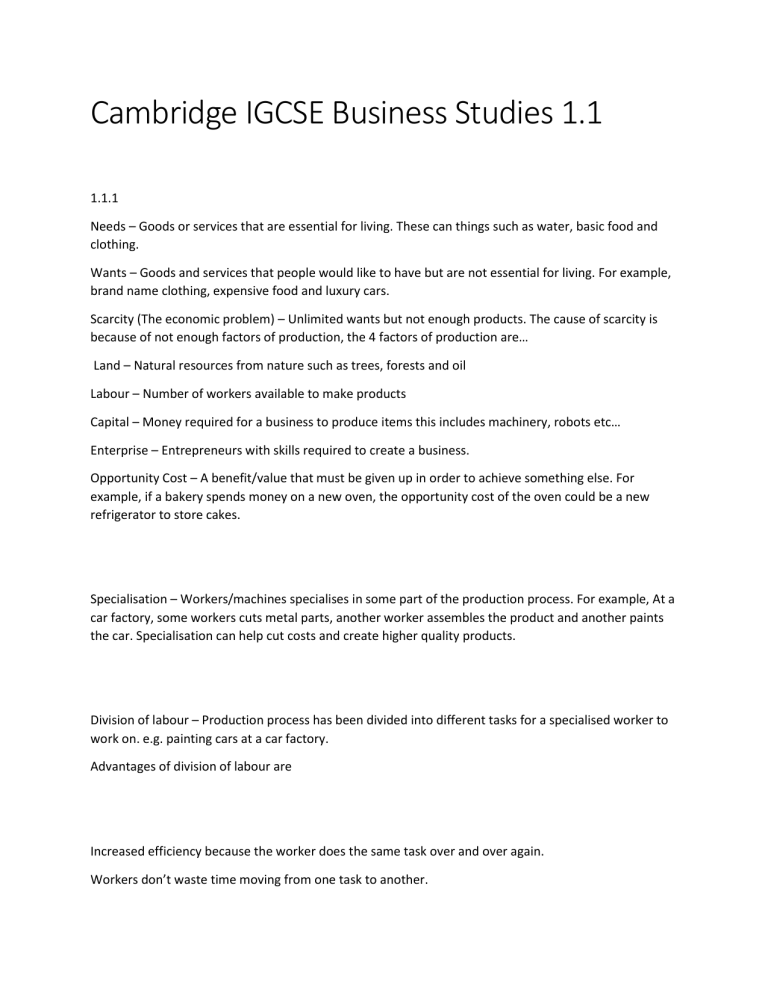
Cambridge IGCSE Business Studies 1.1 1.1.1 Needs – Goods or services that are essential for living. These can things such as water, basic food and clothing. Wants – Goods and services that people would like to have but are not essential for living. For example, brand name clothing, expensive food and luxury cars. Scarcity (The economic problem) – Unlimited wants but not enough products. The cause of scarcity is because of not enough factors of production, the 4 factors of production are… Land – Natural resources from nature such as trees, forests and oil Labour – Number of workers available to make products Capital – Money required for a business to produce items this includes machinery, robots etc… Enterprise – Entrepreneurs with skills required to create a business. Opportunity Cost – A benefit/value that must be given up in order to achieve something else. For example, if a bakery spends money on a new oven, the opportunity cost of the oven could be a new refrigerator to store cakes. Specialisation – Workers/machines specialises in some part of the production process. For example, At a car factory, some workers cuts metal parts, another worker assembles the product and another paints the car. Specialisation can help cut costs and create higher quality products. Division of labour – Production process has been divided into different tasks for a specialised worker to work on. e.g. painting cars at a car factory. Advantages of division of labour are Increased efficiency because the worker does the same task over and over again. Workers don’t waste time moving from one task to another. Disadvantages Workers may become bored doing the same task which results in decreased efficiency Production may stop if one worker doesn’t do job Added Value = Selling price of the product – Cost price (materials etc…) Value added is the difference between the selling price of a product and the cost to produce it. Added value can be increased by either charging higher prices for the same product or by reducing the cost of a product by lowering quality e.g. using cheaper materials. Cambridge IGCSE Business Studies 1.2 – Classification of businesses 1.2.1 Economic Sectors Primary Sector – Extracts and uses the natural resources from the earth. e.g. Fishing, farming Secondary Sector – Manufacture goods using raw materials from primary sector. e.g. Car manufacturers and other factories Tertiary Sector – Provides service to consumers and other sectors of the industry e.g. Restaurants, car showroom, travel agent Importance of economic sector The sector with the most workers is the most important in a country. or The sector with most valuable goods/service is the most important in a country. Changes in sector importance De-industrialisation – when manufacturing sector becomes less important in a country. Why the importance of sectors changes? Primary sector resources get used up e.g. overfishing, deforestation. Factory costs (usually wages) are too high e.g. wages in China/India are cheaper People spend more on the tertiary sector as they become wealthier. e.g. more restaurants, travel agents 1.2.2 Mixed Economy Private Sector – Businesses not owned by the government but by private individuals. (Goal = Profit) Advantages High efficiency and lower costs Competition is encouraged (prices will be lower) Disadvantages Some services may be closed (run out of money) Workers may lose jobs to improve efficiency/cut cost (private sector business does not care about employment rates in countries) Public Sector – Government/State owned businesses. (Goal = non-profit, service for all citizens) e.g. Electricity, police, public transit Advantages Business is funded by government Encourage more jobs Disadvantages Low efficiency No competition between businesses


